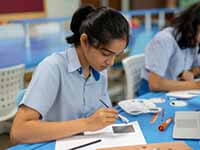Based on a conversation with Ms. Manju Nair, GIIS SMART Campus IB PYP Coordinator
For many young students, the idea of taking a test can be daunting. At GIIS, we remind our students that assessments are a tool to become self-regulated learners, reflect on progress and set future goals for learning. Assessment results in the IB Primary Years Programme (IB PYP) are never used as a punishment or a reward. It is constructive feedback on the overall learning experience of the student who plays a vital role in this process.
The assessment strategies evaluate the conceptual understandings, knowledge acquired and the skills developed throughout the learning process. Both the formative and summative assessments are an opportunity for self-reflection, for students and teachers. While the formative assessment is integrated into the daily learning process, summative assessments are held upon the completion of each unit of inquiry or unit of study.
There are four domains of assessments within the PYP curriculum in an IB school:
● Monitoring Learning — This aims to keep a check on progress in learning against personal learning goals and success criteria. Tools are used by the teachers to monitor student participation, engagement in classroom activities, etc. Teachers provide students with positive and actionable feedback to help them grow individually. Feedback is presented in a way that allows students to reflect on their progress.
● Documenting Learning — As part of this domain, teachers document each student’s progress and student portfolios are maintained which showcase a child’s learning journey, success and reflection. Monitoring learning and documenting learning are critical in providing students with the actionable feedback they need to grow.
● Measuring Learning — Here the aim is to measure conceptual understanding, knowledge acquired and skills developed.
● Reporting Learning: In GIIS we generate formal progress reports two times a year, hold two Parent Teacher Conferences and one Student Led Conference in a year. There is documentation of assessments and evidence of learning is made visible throughout the year through assemblies, celebrations of learning and meetings with parents whenever they request for one.
What Does GIIS Assess?
At GIIS, we look at a variety of factors when evaluating. Here is what is assessed after a unit of inquiry culminates:
● Facts and Skills
● Knowledge and Content
● Understandings and Concepts
● Action Taken after Understanding

Assessment Tools and Strategies at GIIS
At GIIS, we consider the assessment tools to be the “whats” of the assessments, while the strategies are the “hows” of the assessments.
Our assessment tools include:
● Assigning students open-ended tasks to complete to evaluate how they achieve those tasks.
● Offering Exemplars to determine a student’s understanding of a concept.
● Creating rubrics for students to follow during the assessment.
● Teachers maintain anecdotal records of their findings and observations.
Our assessment strategies include:
● Observing students as they work and making notes on their learning styles.
● Asking students factual, debatable and conceptual questions and engaging in discussions to gauge their real-world understanding of a concept.
● Requiring students to present the material that they have learned using digital media and other resources.
● Requiring students to complete a portfolio that includes a summary of their conceptual understanding, knowledge and skills acquired throughout the unit of inquiry.
How Does GIIS Make PYP Assessments Effective?
We believe that an effective assessment is a community effort. We strive to provide assessments in which all members of the learning community — including the teachers, students, parents and school administrators — are informed of progress along the way and provided with opportunities to get involved in each individual’s learning journey.
Here’s what that means:
● Students play an active role in their learning experience. They are given plenty of opportunities for self-reflection on their progress. In addition, they perform peer evaluations in order to assess their classmates.
● Teachers constructively offer timely feedback to all students. They reflect on their teaching practices and methods and calibrate their teaching strategies based on the data they collect.
● Parents stay informed throughout the entire learning journey, as teachers provide feedback and information on progress on apps such as Toddle.
● School administrators review assessment results to evaluate the depth of the school curriculum and the effectiveness of teaching methods being used in the school.
Understanding the Core of GIIS Assessment Strategies
At the core of our assessment strategies are two fundamental concepts — authentic assessments and positive feedback. Here’s what you, as parents, need to know about that:
● Authentic Assessments — Authentic assessments allow students to address large ideas and concepts while simultaneously measuring their progress over a specific period of time. A scoring framework is used to evaluate the tasks completed. The tasks assigned as part of the assessment are designed to evaluate a student’s effort and learning, not their talent. Students receive feedback from these assessments that allow them to partake in self-reflection.
● Positive Feedback — Positive feedback is used to provide students with the support they need to keep learning and growing. Timely, specific and well-considered feedback is given to each student as part of the assessment process.
We feel that our assessment process at GIIS allows students to receive the feedback they need to continue to grow. It also helps them become accustomed to the idea of assessments, which will be part of their regular lives throughout adulthood. Ultimately, these assessments set them up for success both within the classroom and out in the real world, which uniquely prepares them for life in the 21st century.
For more information on IB PYP at GIIS, please don’t hesitate to contact our friendly admissions counsellors.

































